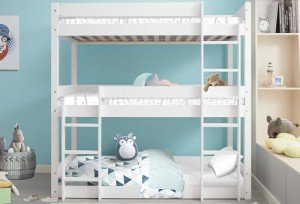The Most Hilarious Complaints We've Heard About Bunk Bed
A Comprehensive Guide to Children's Bunk Beds: Styles, Benefits, and Safety Considerations
Bunk beds have actually become a popular option for households wanting to make the most of space and offer a fun sleeping environment for kids. With try these out , they offer an innovative and practical service for shared bed rooms, playrooms, and even guest accommodation. This article checks out the different designs of children's bunk beds, their benefits, security considerations, and responds to some frequently asked concerns.
The Allure of Bunk Beds
Kid's bunk beds are more than simply space-saving structures; they are also an entrance to adventurous dreams and creative play. Below is an in-depth examination of their numerous advantages.
Advantages of Bunk Beds
- Space-Saving: Bunk beds efficiently make use of vertical space, making them a perfect choice for smaller rooms.
- Lively Design: Many bunk bed styles include slides, tents, and themed aspects, stimulating imagination and excitement.
- Partner Sharing: Bunk beds are best for brother or sisters sharing a room or accommodating slumber parties.
- Flexible Use: Some models can be separated into 2 specific beds, using versatility as kids grow.
- Storage Options: Many bunk beds include built-in drawer storage or racks, even more boosting their usefulness.
Styles of Children's Bunk Beds
The variety of bunk beds readily available today deals with different choices and requirements. Below is an introduction of some popular designs.
Design
Description
Best For
Standard Bunk Bed
A traditional design including one bed stacked above another.
Brother or sisters sharing a space.
Loft Bed
Similar to a bunk bed without the bottom bunk, allows for a work space or play location below.
Limited space for play/desk.
L-Shaped Bunk Bed
Two beds set up in an L-shape, typically with extra areas for storage or play.
Distinct room layouts.
Twin Over Full
A twin bed over a full bed, accommodating different sleep requirements.
Growing children and teens.
High Sleeper
Stands even greater than a loft bed, typically including a desk or play area below.
Older kids requiring more play/desk space.
Camping Tent Bunk Bed
Bunk beds with a canopy or tent-like structure, creating a relaxing, fun space.
Active and creative children.
Secret Features to Consider
When choosing the right bunk bed for kids, the following features are worth considering:
- Material: Bunk beds can be made from wood, metal, or a combination. Each has its special visual and durability.
- Weight Capacity: Always verify the weight limit of the bunk bed to guarantee it can accommodate your kids securely.
- Security Rails: Ensure the leading bunk has durable rails to avoid falls.
- Ladder Security: A properly designed ladder ought to use simple and safe access to the upper bunk.
- Ending up: Ensure any finishes are non-toxic and safe for kids.
Security Considerations
Security is critical when it concerns children's bunk beds. The following standards need to be complied with:
- Age Appropriateness: Generally, children under 6 years of ages ought to not oversleep the upper bunk due to safety risks.
- Sturdy Construction: Ensure the frame and materials are solid and can support the weight without drooping.
- Routine Maintenance: Periodically check for loose screws, bolts, or other elements that might require tightening.
- Clear Play Area: Keep the area around the bunk bed without toys and barriers to reduce tripping hazards.
Setting Rules for Safe Use
Developing standards for bunk bed use will help guarantee safety:
- Limit Jumping and Climbing: Children ought to be recommended against leaping from the leading bunk and climbing on the sides.
- Supervising Sleepovers: Monitor young visitors while they are utilizing the bunk bed for the very first time.
- Educate on Ladder Use: Teach how to utilize the ladder safely, stressing the importance of dealing with the ladder when going up or down.
Regularly Asked Questions
1. What age is suitable for a child to sleep in the leading bunk?
A lot of producers suggest that children should be at least 6 years old to oversleep the upper bunk. This standard is designed to alleviate the danger of falls.
2. Can bunk beds be personalized?
Yes, lots of makers offer customizable options, consisting of colors, materials, and additional functions like drawers or desks.
3. Are bunk beds safe for weight?
Bunk beds have weight limits, generally ranging from 200 to 400 pounds, depending on the model and product. Constantly inspect the producer's specs.
4. How do I preserve and clean a bunk bed?
Routinely inspect for loose parts, keep the bed clean by cleaning down surface areas, and guarantee the bedding is fresh to promote a safe and hygienic sleep environment.
5. Can bunk beds be separated into individual beds?
Lots of bunk beds include an option to separate them into two individual beds, providing long-term flexibility.
Children's bunk beds are more than mere furniture; they are a functional, versatile, and imaginative component of a kid's room. With various styles offered and various safety factors to consider to remember, parents can pick the best bed that fits their space, fulfills their kids's requirements, and imparts a sense of adventure. By comprehending the benefits, designs, and safety procedures related to bunk beds, families can produce a delightful and safe and secure sleeping environment for their children. Whether for siblings sharing a room or space-saving solutions, bunk beds stay a precious option for lots of families.
